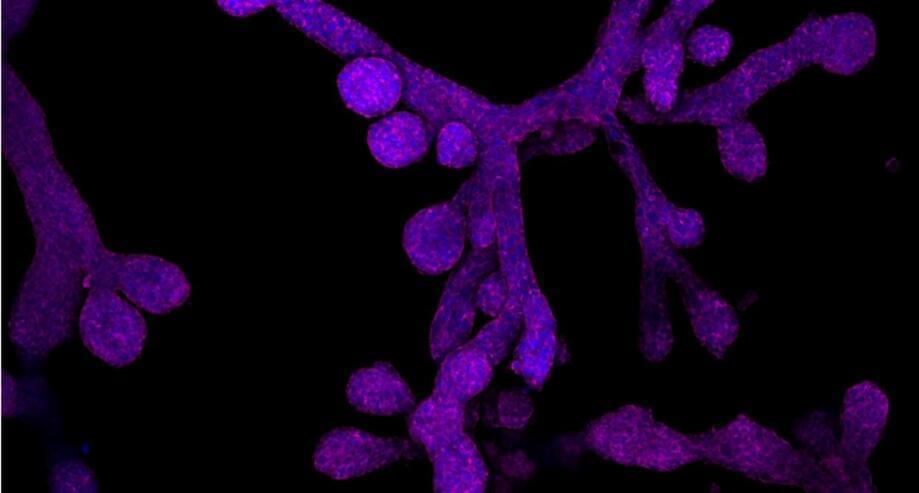Organoids of mammary glands can help researchers more efficiently study lactation, with findings that could apply to fields ranging from agriculture to medicine.



Scientists from the Department of Physical Chemistry at the Fritz Haber Institute have made an innovative discovery in nanoscale optoelectronics, as detailed in their recent publication in Nature Communications (“Atomic-Precision Control of Plasmon-Induced Single-Molecule Switching in a Metal–Semiconductor Nanojunction”).
The study introduced a groundbreaking method for achieving unprecedented control over single-molecule photoswitching. This breakthrough could transform the future of nanodevice technology.
Schematic view of the plasmon-driven switching of a single PTCDA molecule. (Image: Fritz Haber Institute)
Nervous system disorders are among the leading causes of death and disability globally.
As brain research advances, how should study participants be protected? Bioethicist Saskia Hendriks has some ideas.
(back to outline)
Robert J. Sternberg has devoted much of his career to the study of various conceptions of human intelligence. Starting with his Triarchic Theory of Human Intelligence (Sternberg, 1985), he has expanded on his view of human ability and success. Successful intelligence is defined as that set of mental abilities used to achieve one’s goals in life, given a socio-cultural context, through adaptation to, selection of, and shaping of environments. Successful intelligence involves three aspects that are interrelated but largely distinct: analytical, creative, and practical thinking (Sternberg, 1998). Practical Intelligence is the ability to size up a situation well, to be able to determine how to achieve goals, to display awareness to the world around you, and to display interest in the world at large (Sternberg, 1990; Sternberg et al., 2000; Wagner, 2000). Prof. Sternberg is working on several projects that examine the interrelation of his various conceptions of ability in applied settings.

Sternberg has proposed what he refers to as a “triarchic theory” of human intelligence.14 The original version of the theory is triarchic in that it argues that intelligence comprises three sets of skills: creative, analytical, and practical. In its augmented version, it specifies the importance of wisdom-based skills as well. According to this theory, people are intelligent in their lives to the extent that they: (i) formulate and achieve goals that help them attain what they seek in life, given their cultural context; (ii) by capitalizing on their strengths and compensating for or correcting weaknesses; (iii) in order to adapt to, shape, and select environments; (iv) through a combination of essential skills. As mentioned above, the essential skills are: (i) creative skills to generate novel ideas; (ii) analytical skills in order to assure that the ideas are good ones; (iii) practical skills in order to implement their ideas and persuade others of their value; and (iv) wisdom-based skills in order to ensure that the ideas help to achieve a common good over the long as well as the short term through the infusion of positive ethical values.
The various aspects of the theory—analytical, creative, practical, wisdom—are measurable. Sternberg has shown that when they are measured, they improve prediction of both academic and nonacademic performance in university settings and reduce ethnic-group differences.15 Teaching that incorporates the various aspects of intelligence Increases academic performance relative to conventional teaching.16 Sternberg has argued that intelligence is at least somewhat malleable throughout the lifespan.
The problem of intelligence — its nature, how it is produced by the brain and how it could be replicated in machines — is a deep and fundamental problem that cuts across multiple scientific disciplines. Philosophers have studied intelligence for centuries, but it is only in the last several decades that developments in science and engineering have made questions such as these approachable: How does the mind process sensory information to produce intelligent behavior, and how can we design intelligent computer algorithms that behave similarly? What is the structure and form of human knowledge — how is it stored, represented, and organized? How do human minds arise through processes of evolution, development, and learning? How are the domains of language, perception, social cognition, planning, and motor control combined and integrated? Are there common principles of learning, prediction, decision, or planning that span across these domains?
This course explores these questions with an approach that integrates cognitive science, which studies the mind; neuroscience, which studies the brain; and computer science and artificial intelligence, which study the computations needed to develop intelligent machines. Faculty and postdoctoral associates affiliated with the Center for Brains, Minds and Machines discuss current research on these questions.
Learn about the Science of Intelligence through video lectures organized into series aimed at a general audience, the undergraduate level, and the research community.

How can scientists protect biodiversity across the Earth while climate change continues to ravage the planet? This is what a recent study published in Conservation Biology hopes to address as an international team of researchers investigated how conservation efforts within the Southern Ocean should be addressed due to human activities (i.e., tourism, climate change, and fishing). This study holds the potential to help scientists, conservationists, and the public better understand the negative effects of human activities on the Earth’s biodiversity, specifically since the Southern Ocean is home to an abundance of species.
“Despite the planet being in the midst of a mass extinction, the Southern Ocean in Antarctica is one of the few places in the world that hasn’t had any known species go extinct,” said Sarah Becker, who is a PhD student in the Department of Environmental Studies at the University of Colorado Boulder (CU Boulder) and lead author of the study.
For the study, the researchers used the Key Biodiversity Area (KBA) standard—which used to identify sites of vital importance to preserving biodiversity—to examine species within the Southern Ocean. After analyzing tracking data for 13 Antarctic and sub-Antarctic seabirds and seals, the researchers found a total of 30 KBAs existed within the Southern Ocean, specifically sites used for migration, breeding, and foraging. This study improves upon previous research that identified KBAs on a macroscale, whereas this recent study focused on sites at the microscale. The researchers hope this study will help raise awareness for mitigating fishing activities in these areas along with developing improved conservation strategies, as well.

A new algorithm may make robots safer by making them more aware of human inattentiveness. In computerized simulations of packaging and assembly lines where humans and robots work together, the algorithm developed to account for human carelessness improved safety by about a maximum of 80% and efficiency by about a maximum of 38% compared to existing methods.
The work is reported in IEEE Transactions on Systems, Man, and Cybernetics: Systems.
“There are a large number of accidents that are happening every day due to carelessness—most of them, unfortunately, from human errors,” said lead author Mehdi Hosseinzadeh, assistant professor in Washington State University’s School of Mechanical and Materials Engineering.
Researchers have demonstrated a technique for printing thin metal oxide films at room temperature, and have used the technique to create transparent, flexible circuits that are both robust and able to function at high temperatures.
The paper, “Ambient Printing of Native Oxides for Ultrathin Transparent Flexible Circuit Boards,” was published August 15 in the journal Science.
“Creating metal oxides that are useful for electronics has traditionally required making use of specialized equipment that is slow, expensive, and operates at high temperatures,” says Michael Dickey, co-corresponding author of a paper on the work and the Camille and Henry Dreyfus Professor of Chemical and Biomolecular Engineering at North Carolina State University.